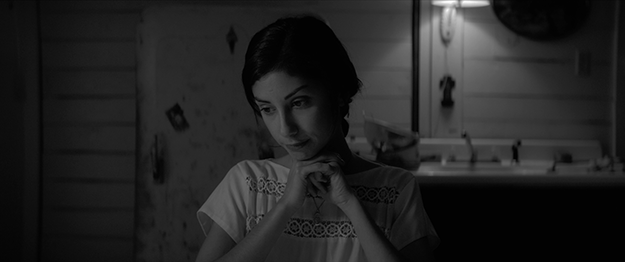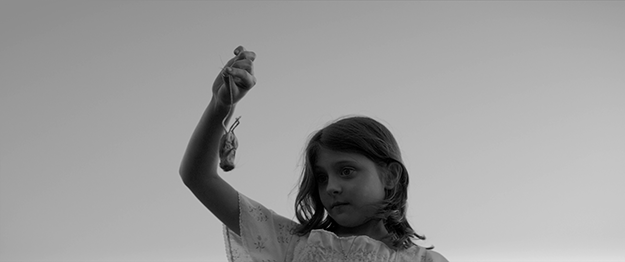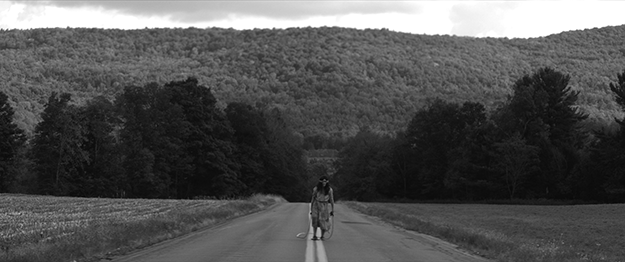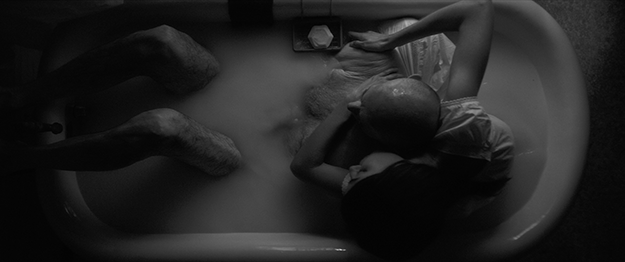Film of the Week: The Eyes of My Mother

Why, in this day and age, make films in black and white? For Film Comment readers, that might seem a question hardly worth asking; we all know which black-and-white films, whether or not they’re channeling styles of the past, we find arresting, seductive, or poetic in ways they might not have been if shot in color. But sometimes you know a film needs a very limited palette, in order to not show certain things—perhaps grisly things that we’d prefer not even to guess at. Black and white can be the perfect choice for what you might call the “charnel house” movie, of which there’s a particularly striking new example: Nicolas Pesce’s The Eyes of My Mother.
Set somewhere in the American hinterland, at some indefinable point in time, the film—backed by Borderline Films, with Sean Durkin, Josh Mond, and Antonio Campos as executive producers—is the story of a young woman named Francisca (Kika Magalhaes). She has grown up on a farm with her Portuguese mother (Diana Agostini), who was apparently a surgeon back in the old country; quite how she ended up married in a remote stretch of U.S. countryside is, like so many things here, tantalizingly left unclear. The first of three chapters—entitled “Mother”—finds Francisca as a little girl (Olivia Bond), learning from Mama about eyes, apparently her specialty as a medic: St. Francis, she tells the girl, “died of an eye condition that also caused psychosis.” (I assumed Pesce had made up this bizarre touch, but apparently not.) Mama also tells her that cows’ eyes are very similar to those of humans: cut to a severed bovine head on the kitchen table, as Mother—with shades of Un Chien Andalou—demonstrates exactly what she means.
Then a grinning, white-shirted stranger named Charlie (an immensely disturbing performance from Will Brill) turns up on the front lawn. He’s a reasonable man—he only wants to use the bathroom, he says. In fact, he has something more drastic in mind—and this is the point at which Pesce starts making it hard for us to know exactly what’s going on at any given point, and why. Something awful happens, but whatever it is, it happens off-screen, cloaked in awful silence as young Francisca looks on (the extraordinarily elegant sound design by Patrick Burgess makes especially resonant use of quiet). Now her father (Paul Nazak) comes home—a taciturn, desiccated elder who seems to have just stepped off the canvas of Grant Wood’s American Gothic. He barely says a word, and we don’t see quite what he does, either: but Pesce and co-editor Connor Sullivan cut discreetly to a shot of Francisca washing the bathroom floor, on which there’s a pool of… what? Blood, presumably—but there’s no red to shriek that information at us unequivocally. And that—like later scenes in which Francisca wraps certain unidentified things in plastic—shows why the film had to be in black and white.

There are other reasons why Zach Kuperstein’s photography works so perfectly—like the chiaroscuro of the scene in which Francisca and Dad bury her mother at night, surrounded by a brilliant halo of white light. Now things get stranger and darker, and eventually more explicit, so cue SPOILER ALERT: Charlie is still alive and living in the family’s barn. There Francisca, in between doing strange things to him—and here the use of black and white is nothing less than merciful, both to our sensibilities and to his dignity—engages him in artless conversation. “Why us?” she asks. “Why us?” He replies, “You let me in.”
Charlie doesn’t get to say a great deal more, for reasons that aren’t quite made overt, but that we can guess at with a shudder. As for Dad, he ends up silent because he’s dead, but Francisca, now a grown woman, keeps him company and looks after him (shades of William Faulkner’s “A Rose for Emily”): she sits him down on the sofa in front of the TV, where there always seems to be a Western playing, cuddles up, kisses him, then gives him a bath, the water sloshing in slow motion. Later, Francisca drives to a bar and brings home a young woman (Clara Wong); things look promising between them in a drawn-out, delicate scene, but a woman with Francisca’s family history is unlikely to be a dream date.
Things get darker still in the third chapter, “Family,” as Francisca rebuilds a new family of her own. It starts with her getting a lift from a young woman in a car; Francisca proves the least desirable female chance encounter for a mother and child since François Ozon’s See the Sea. What transpires is acutely painful, at first mainly in psychological terms: the emotional tension ramps up horribly as we hear a baby’s screaming somewhere off screen (in all fairness, anyone sensitive about small children, or indeed about small children’s parents, should be warned not to expect a good time).

The elliptical finesse of Pesce’s style sustains itself pretty much consistently throughout the three chapters, and the more elegantly indirect his staging, the more of a tour de force the film is. His and Kuperstein’s great moment is a scene viewed from inside the house looking out through a window. A figure slowly moves away from us, staggering up a hill; off screen, we hear Francisca open a door, take out something metallic from a drawer; after a moment, she passes by on the other side of the window, and eventually is seen pursuing the figure up hill. What adds a further exquisite chill is a little non-narrative detail: a glimpse of white sheets blowing at the very edge of the window.
The film becomes a lot less resonant, and less original, in the third part—partly because the horror is more explicit, partly because what earlier happens to a man now happens to a woman—and although what we see is strictly a repetition of Charlie’s fate, it feels more generically punitive. The sound of chains dragging on a floor, the sight of fingernails scraping against splintered wood are hard to take, however beautifully these elements are executed; by this point, I started to wonder whether, for all its grace, The Eyes of My Mother is really that different from the brutish likes of, say, Martyrs (Pascal Laugier, 2008; remade by Kevin and Michael Goetz, 2015). But the most sadistic moment, purely in terms of twisting the knife in the viewer’s sensibility, is the shot of a young boy standing in the doorway to the barn, looking in, the soft animal toy he’s holding silhouetted in the light from behind. It’s the only moment in the film that, perhaps precisely because of that exquisitely limned detail, feels as if it’s crassly pushing our buttons.
Pesce undeniably has a vision and a mastery very much his own; this is as idiosyncratic a genre-tweaking debut as Ana Lily Amirpour’s A Girl Walks Home Late at Night (Eyes could almost be retitled A Girl Stays Home Late at Night). Sam Hensen’s production design keeps the period ambivalent: the story appears to be set now, but for much of it, you wonder whether we’re actually in the ’60s, ’50s, even the ’30s; the house’s dark, dully furnished interiors echo both The Night of the Hunter and, perhaps inevitably, Psycho (a doll propped up in a chair presumably stands in for Mother). The nightmare scenario of familial coziness also suggests something like The Texas Chainsaw Massacre remade as an exceptionally refined Portuguese art film.

In addition, Ariel Loh provides an eerie electric score that feels unsettlingly disconnected from the action, and there are also songs by the great Portuguese fado singer Amália Rodrigues. And there’s an utterly unnerving performance at the center of it all: Kika Magalhaes embodies both distracted menace and a strange, other-worldly fragility. All in all, this is a compellingly strange film, and definitely the real thing, even if it’s finally not 100 percent my thing. It’s a film that sometimes withholds, sometimes shows us too much, and is definitely more effective in the latter mode. Straight-down-the-line horror fans may wonder, though, quite what the delicacy is for, and whether the use of black and white to spare, or to taunt, our nerves is really about understatement, or more a sort of visual euphemism.
Jonathan Romney is a contributing editor to Film Comment and writes its Film of the Week column. He is a member of the London Film Critics Circle.







